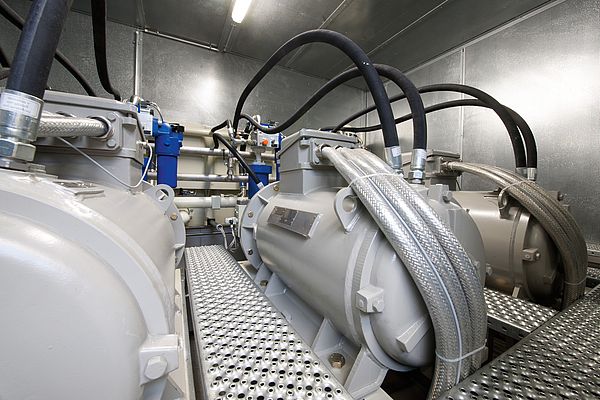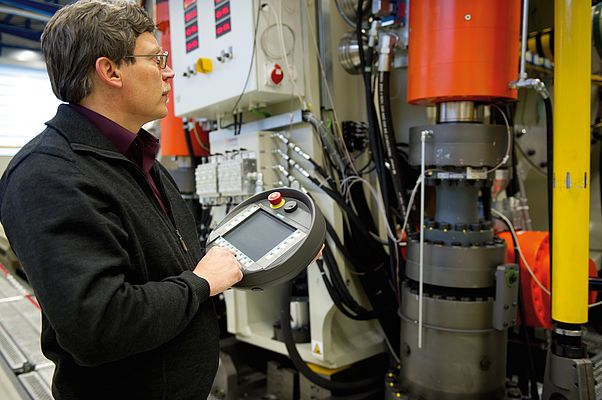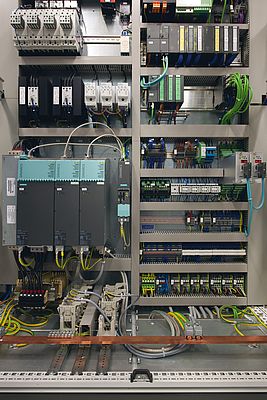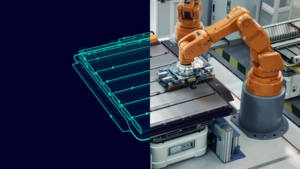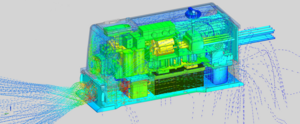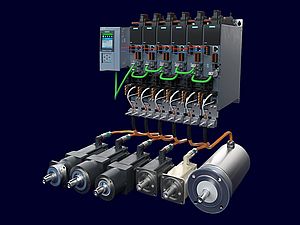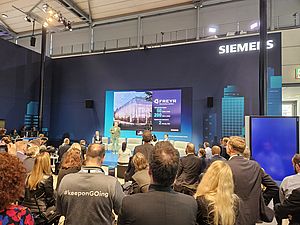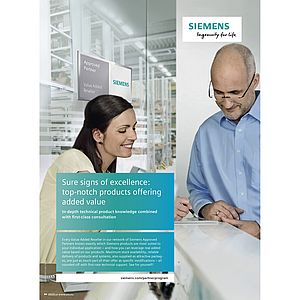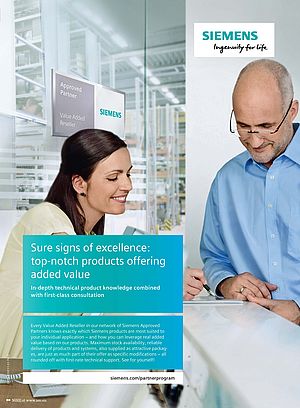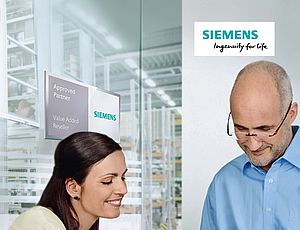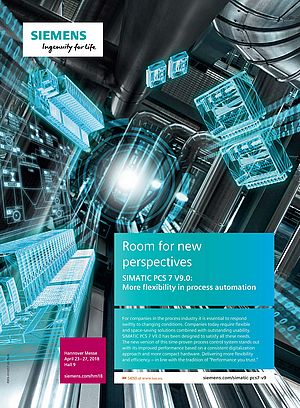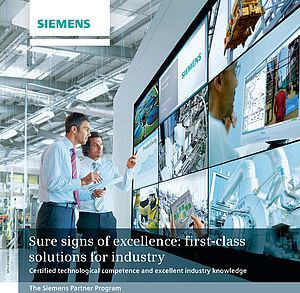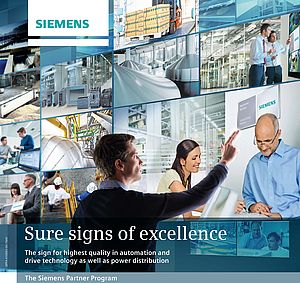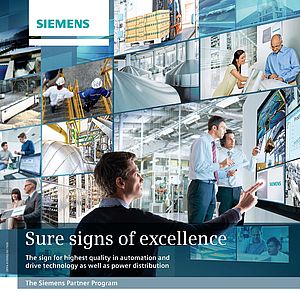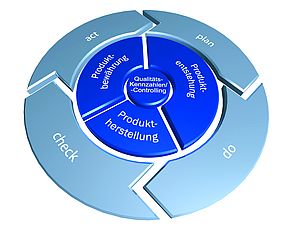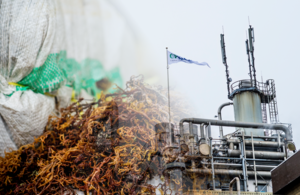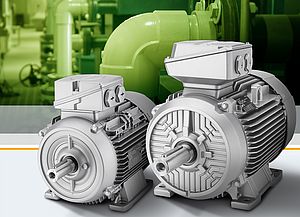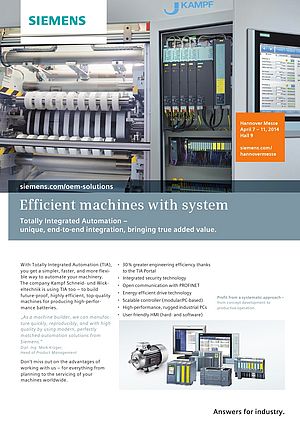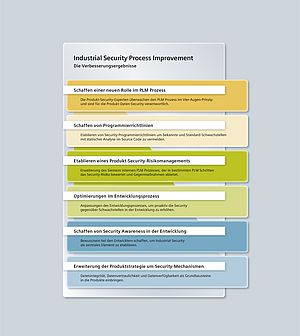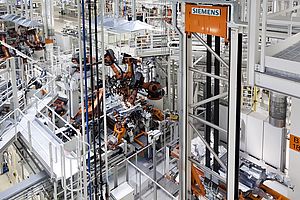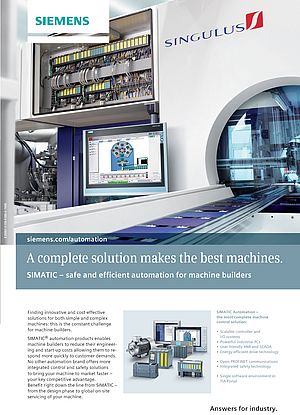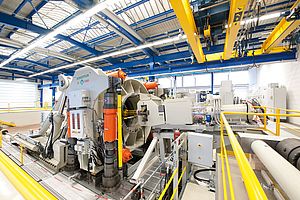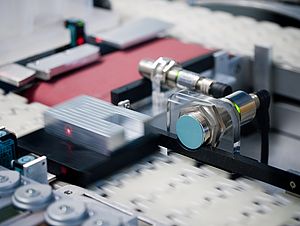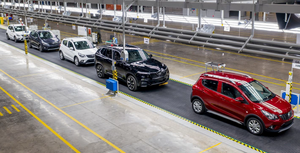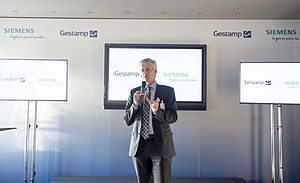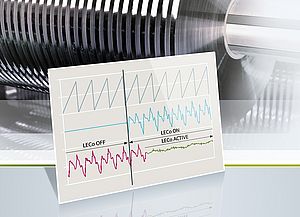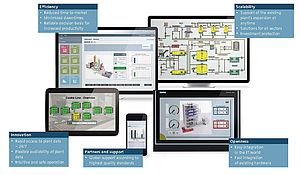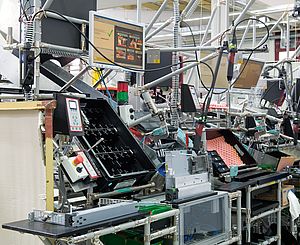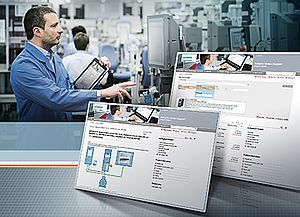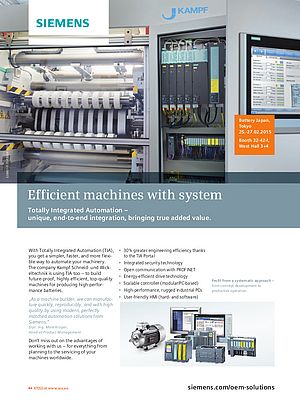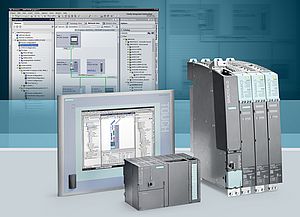To simulate the complex, wind-driven behavior of offshore wind turbines of the multi megawatt class in a very realistic setting on the world's largest test stand for large bearings located at Schaeffler in Schweinfurt, perfect interaction between the components and systems used in these turbines is required. This interaction is provided by a fully integrated drive train that is seamlessly integrated into the automation and communication technology specifically selected for this task.
Schaeffler Technologies AG & Co. KG in Schweinfurt is a leading manufacturer of roller bearings and precision components for customers in the areas automotive, industry and aerospace. In addition to the classical fields of application in the industrial environment, the Industry division of the company has successfully developed and manufactured bearings for wind turbines for more than 30 years. To test these turbines under very realistic conditions, Schaeffler decided to develop a 6 MW large bearing test stand that is considered one of the most technologically advanced, largest and most powerful large bearing test stands in the world. It can be used to test large bearings weighing up to 15 tons with an external diameter of up to 3.5 meters that are predominantly used in wind turbines with the help of a comprehensive simulation program.
Reliability and availability are crucial for the efficiency of such wind turbines - especially in the offshore sector. The same is true for the drive and automation solution. Siemens was involved as a technology partner starting with the design phase of the test stand. The customer was won over by the total concept including the communication solution with Industrial Wireless LAN (IWLAN) as well as the supplied components.
Reliable drive technology creates realistic wind situations
The main load (with 150,000 Nm) is carried by an integrated drive train based on Siemens components, consisting of a gearbox from the Flender series, a motor from Loher and a cabinet-type frequency converter of the Sinamics S150 family. The gearbox is extremely rugged and thus ensures the high availability of the entire drive train. The drive motor and the Sinamics S150 frequency converter are also very dependable. Loher motors can be customized to meet the individual application.
The specific speed specifications were important for the large bearing test stand "Astraios", and the motor had to be specifically designed to meet these required values: These are 625 min-1 that have to be converted into the 12.5 min-1 typical for wind turbines at an average main load - while providing a wide speed setpoint range of nearly 3,000 min-1. The Loher motor itself provides 300 kW and is water-jacket cooled, mainly to avoid additional heating of the room. The regenerative Sinamics S150 converter precisely and dynamically controls the motor speed and the resulting reaction times which correspond to the behavior of the rotor in case of a change in wind force. Regenerative means it feeds the brake energy that is generated when braking the rotor in the simulation back into the power supply. This is of course much more energy-efficient than dissipating the released energy in a braking resistor in the form of heat as it is frequently done.
Every aspect of the entire drive train consisting of gearbox, motor and frequency converter is matched to the special requirements of the large bearing test stand, such as an integrated emergency stop that ensures safe braking within seconds. The drive technology from Siemens is not only responsible for simulating the main load, but also for the auxiliaries, such as the hydraulic pumps. These simulate the changing and irregular effect the wind has on the rotor and create dynamic pitching and yawing moments (see text box). Three water-cooled motors from Loher with 160 kW and controlled by Sirius soft starters are used for this purpose. Simotics SD low-voltage induction motors are used for the twelve lube oil pumps. These are controlled and coordinated by Sinamics S120 converters for multi-motor drives. The harmonized interaction of the drive components in all test stand applications increases reliability and efficiency.
Perfect interaction of drive and automation technology
The interaction of components and systems is not limited to the drive technology in the large bearing test stand "Astraios". The integrated drive train fits seamlessly into the automation landscape of the test facility. It communicates continuously and very quickly with the controllers of the Simatic S7-300 family using of PROFINET to output, among other things, the exact setpoint value specifications to the drives for simulation of the changing wind conditions.
A Simatic S7-319 is used as main controller in the control cabinet, serving as higher-level controller of the main drive as well as for additional systems, such as a wireless solution. Another fail-safe controller of the same product family is installed in the control cabinet; it is responsible for the safety-related communication of the controllers with the individual areas (hydraulics, lubrication, etc.). The controllers are very powerful so that even complex tasks can be executed in real time. Components of the Simatic ET 200 distributed I/O are used at the field level. They communicate with the different actuators and sensors and are directly linked to the controllers.
Communication takes place via PROFINET and PROFIsafe. PROFINET transmits process-related and safety-related information in real time using the same bus. This reduces additional wiring effort and therefore costs. PROFINET also allows for central diagnostics of each individual device in the field. Errors can be detected and addressed in time. PROFIsafe ensures that the system runs safely for man and machine, which is particularly important for rotating parts. The system can be stopped immediately by means of the fail-safe controllers and the emergency stop function.
Wear-free transmission of measured data with Industrial Wireless LAN
Communications design was a key challenge for the rotor test stand. The requirements not only call for wear-free transmission of measured data of different temperature values of the rotating specimen but also for convenient, mobile and safe control and monitoring of the test stand including safety functionality in the entire area around the system. Two independent wireless networks form the basis of meeting this requirement.
The objective of measured data transmission is to capture the temperature values, velocity and bearing forces of the rotating specimen and to transmit these values to the main controller via IWLAN. The Simatic ET 200pro distributed I/O system collects the measured values of the sensors in this process and transmits them to the control room. A Scalance W788-1RR access point on the stationary part of the system is responsible for wireless data transmission; together with an RCoax radiating cable it forms a defined RF field. Its counterpart is the Simatic ET 200pro with the IWLAN interface module on the rotating bearing test stand; it uses an RCoax directional antenna to transmit the signals. The required WLAN availability for transmission of measured data can be guaranteed by the RCoax special antenna even at rotational speeds of up to 60 min-1. The wear-free and almost maintenance-free IWLAN solution without collector rings guarantees reliable data transmission and helps optimize overall costs.
Safe control and monitoring with Mobile Panel and IWLAN
The Mobile Panel Simatic MP 277F IWLAN is used for control and monitoring including safety functionality. Despite the vast dimensions of the rotor test stand, uninterrupted operation including emergency stop functionality is made possible by Rapid Roaming (iPCF-MC). This means the operator can move around freely within the defined range of the system - without cables and during operation.
This means the operator always has the best view of the system. In addition to convenient operation, the mobile solution meets the safety guidelines specified for systems with rotating parts. This unique solution from Siemens won the customer over immediately. A requirement for reliable communication was to set up an optimum RF field in the vast operating range of the machine that also had a lot of corners. For this reason, the wireless solution for the Mobile Panel was simulated with Sinema E and optimized in the process. The successful computer simulation showed us that two access points of the Scalance W788-2RR series were sufficient for optimal wireless coverage. iPCF (industrial Point Coordination Function) ensures that the wireless connection to the Mobile Panel is always guaranteed even during radio cell change between the two access points.
Integrated overall solution results in highest customer satisfaction
Schaeffler is very pleased with the integration, high availability and reliability of the systems supplied by Siemens. The interaction among all drive and automation components is perfect and considerably minimizes the amount of engineering required. There have been no failures since the system was commissioned. The engineer in charge of the project emphasizes the good cooperation: "Siemens experts were always available to answer any questions we had regarding drive and automation topics. We are very pleased with the cooperation and the entire solution", emphasizes Mr. Reinhold Korn, Technical Director Electrical/System Technology for Test Stand Construction at Schaeffler in Schweinfurt.




